Case studies for the Pulsar II™ Irrigator. The Innovative Solution for Chronic Wound Care Management
Please Note: Our private knowledge hub area contains graphic content that some may find to be uncomfortable viewing.
PULSAR Ⅱ™ offers an innovative and safe pulse irrigation system to provide selective hydro-mechanical debridement to chronic non-healing wounds. It is one such innovation that is worth consideration, and which is suitable for a variety of wounds…
In case 1, it was a postoperative infection wound with diabetes. Prior to treatment with PULSAR Ⅱ™, patient had received treatment for 5 months, and there was no improvement in the wound bed. After about 2 months the wound healed by 3 pieces PULSAR Ⅱ™.

For more information regarding this case study, please contact Wound Care Solutions
Telephone: +1.210.866.3153
info@woundcs.com
Diabetic foot, dry gangrene at the distal limb, mixed gangrene at the proximal limb, wound surface covered with black-green slough, green odour oozing. The patient was in financial difficulty, and his family took care of his wound with Anerdia (A mixture of iodine, chlorhexidine acetate, and alcohol) and ethacridine lactate at home.
One year later, the doctor had his leg amputated. After amputation for about one month his doctor gave 2 pieces PULSAR Ⅱ™ to him for free and told him how to use this system to debride every 2 days and also how to formulate normal saline at home. After several months, the patient returned to the hospital to told his doctor his wound was healed. During these months, PULSAR Ⅱ™ irrigation was the only therapy method.

Before amputation
3-24/18

Amputation
4-14/18

Day 1 -Before irrigation
5-12/18

Day 1 – After irrigation
5-12/18

Day 37 after irrigation
6-19/18

Day 64 after irrigation
7-14/18

Cut off the tibia
9-22/18

Almost healed
11-9/18
For more information regarding this case study, please contact Wound Care Solutions
Telephone: +1.210.866.3153
info@woundcs.com
This woman encountered a car accident, her leg was infected and non-healing for 33 days, facing a risk of amputation. The doctor tried PULSAR Ⅱ™. after 3 times of lavage, new granulation tissue growing. These beef red tissue was the new granulation tissue.

Before

After
For more information regarding this case study, please contact Wound Care Solutions
Telephone: +1.210.866.3153
info@woundcs.com
Female, 70 years old, hepatic carcinomas, acute medicational ulcer. It was very difficult to clean this kind of ulcer because of the hair with tweezers, surgical blade or any other irrigation facilities. With PULSAR Ⅱ™ it was very easy to control.

Before

After
For more information regarding this case study, please contact Wound Care Solutions
Telephone: +1.210.866.3153
info@woundcs.com
This case was an abdominal incision infection. Prior to the use of the Tunnel Tip, an infection developed in the wound, when pressed , a lot of pus exuded out of the wound, making the patient very painful. After 4 times pulse irrigating with the tunnel tip , when pressed, there was little exudation and patient felt no pain. This therapy was very successful.

Tunnel wound debridement

4th debridement-After
For more information regarding this case study, please contact Wound Care Solutions
Telephone: +1.210.866.3153
info@woundcs.com
Type 2 diabetes; DFU Wagner 4; diabetic angiopathy, neuropathy, and retinopathy complications; multiple lacunar infarction; cardiac function II; hypertension grade 2; hypothyroidism; Kidney transplantation. Using pulse debridement repeated debriding the wound to loosen the necrotic crusta and tendon covered on the wound bed, then combined with encroachment and autolytic debridement to get fresh wounds, and then using xenogeneic acellular dermal matrix to promoting wound healing. In the early stage of wound treatment, pulse debridement can clean dead tissue, control wound infection, and improve wound micro-circulation, so played a key role in promoting wound healing.

Before Treatment

1st irrigation
08-08/18

2nd irrigation-Before
9-12/18

2nd irrigation-After
9-12/18

4th irrigation-After
09-21/18

7th irrigation-After
9-29/18

9th irrigation-After
10-17/18

11-07/18

12-26/18

1-25/19

Dressed with xenogeneic acellular dermal matrix
1-25/19

The dressing turned to dry and ready to fall off
2-14/19

Debriding
For more information regarding this case study, please contact Wound Care Solutions
Telephone: +1.210.866.3153
info@woundcs.com
Male, 63 years old, underwent cardiac bypass surgery. 25 days later, the wound in the left inner thigh split with 5 inches long. 55 days later, the wound in the left lower leg split with 13 inches long. A little black exudation, odour, pseudomonas aeruginosa infection, painful, muscle atrophy of the left lower limb. The patient was diagnosed with type 2 diabetes, coronary atherosclerotic heart disease, hypertension, and lower extremity arteriosclerosis obliterans.

Thigh Wound

Leg Wound
Pulse debridement was performed, after the first time, red granulation tissue was observed. Dressing twice a week, each time with pulse debridement. After several times pulse debridement the edge of the wound was gradually loosened and removed, the wound turned red, and the wound began to heal. Showed as the effect of the 5th pulse debridement. After 3 weeks of treatment, the thigh wound healed, and the leg wound healing smoothly

Pulse

Debriding
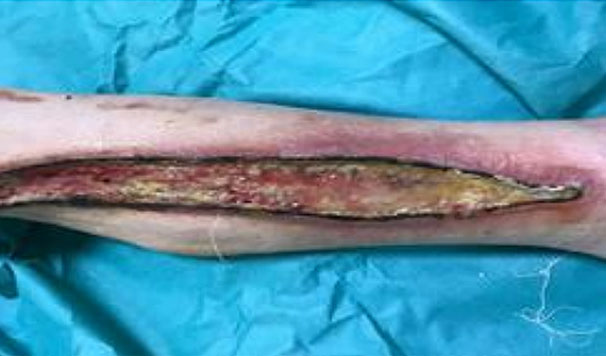
1st irrigation-After

2nd irrigation-After

5th irrigation-After

7th irrigation-After

8th irrigation-After

8th irrigation-After
Closed with film

Healed thigh wound
For more information regarding this case study, please contact Wound Care Solutions
Telephone: +1.210.866.3153
info@woundcs.com
Males, 90 years old, with diabetes, sequelae of cerebral infarction, postoperative of myocardial infarction, bilateral carotid stenosis, hypertension grade 3 (very high risk), thromboangiitis obliterans. The left foot was burnt , unhealed for 40 days healed. The left side of the limbs were inconvenient, taking acesodyne for a long time. Yellow necrotic tissue covered the wound, with no exudation. Before the first treatment, patient felt serious painful, so using wet dress with lidocaine dressed wound bed for 15 minutes, then started to irrigate the wound ,after the first pulse debridement wound slough softening.

Lidocaine dressing

Pulse debriding

1st treatment – Before

1st treatment – After

2nd treatment – Before

2nd treatment – After
Before the second treatment, the wound slough was moist, the edges of the wound were scarred, after the second debridement, the wound was turned red, then dressed with antibacterial peptide gel. The wound pain was relieved. After the third pulse debridement, fresh granulation tissue was observed on the wound surface, and the dressing was the same as before. Epithelial crawling after the fourth pulse debridement, changing a heterogeneous acellular dermal matrix dressing.

3rd treatment – After

4th treatment – After

7th treatment – After
The wound healing smoothly
For more information regarding this case study, please contact Wound Care Solutions
Telephone: +1.210.866.3153
info@woundcs.com
Male, 67 years old; diabetes for 15 years; DFU Wanger4; TEXAS 4 stage3; Neuro-ischemic; Infection: PEDIS,grade3;Gangrene, purulent exudation at the toe root, foul smell. Treatment: Cut off the loosen 2nd and 3rd toes, cleaned gangrene and purulent tissue with pulse irrigation, 2 weeks later, cut off the 1st and 4th toes and irrigated. Covered the wound with heterogeneous acellular dermal matrix dressing, and changed dressings every 2weeks and pulse irrigated. The wound eventually healed smoothly.

Before treatment

2nd 3rd toes amputation Pulse irrigation-Before
7-25/18

2nd 3rd toes amputation Pulse irrigation-After
7-25/18

1st 4th toes amputation Pulse irrigation-After
8-8/18

Covered with heterogeneous acellular dermal matrix dressing

8-20/18

9-11/18

9-26/18

10-15/18

8-20/18

11-21/18

11-21/18
For more information regarding this case study, please contact Wound Care Solutions
Telephone: +1.210.866.3153
info@woundcs.com
Male, 64 years old, type 2 diabetes, DFU, full foot infection, diabetic nephropathy and retinopathy, hypertension grade 3 (very high risk), sequelae of cerebral haemorrhage. Severe anemia, hypoproteinemia, sepsis, wet gangrene for full foot. Treatment: Took incision and drainage to cleaning wet necrosis, opening deep infected tunnel. When the gangrene no longer expanded further, debrided yellow slough with pulse irrigation. Irrigated tunnel wound with tunnel tip.

Before treatment

Incision and drainage

1st irrigation-Before

1st irrigation-After

2nd irrigation-After
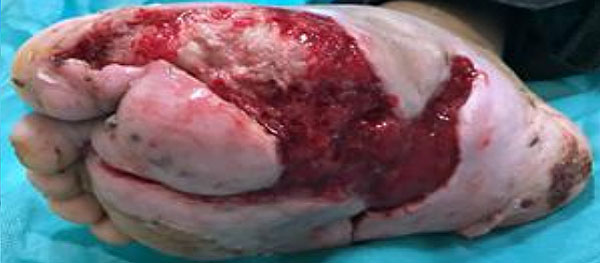
3rd irrigation-After
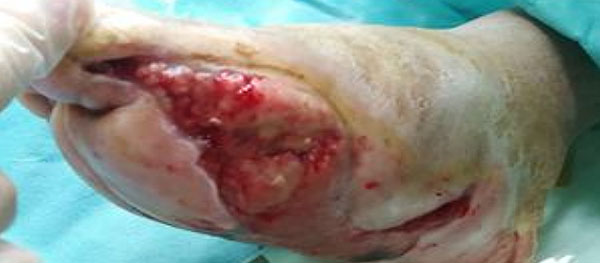
Epithelial crawling, wound size reduced
PULSAR Ⅱ™ AWI™ uses low pressure irrigation 8 to 15 pounds per square inch, generally tolerated with minimal pain or discomfort, using a no touch, no suction technique to remove necrotic tissue, reduce bacterial bioburden, and then enhance chronic wound healing.
For more information regarding this case study, please contact Wound Care Solutions
Telephone: +1.210.866.3153
info@woundcs.com
Images of before & after one treatment of Pulsar II™
Before

After

Before

After

Before

After

Before

After

Before

After

Before
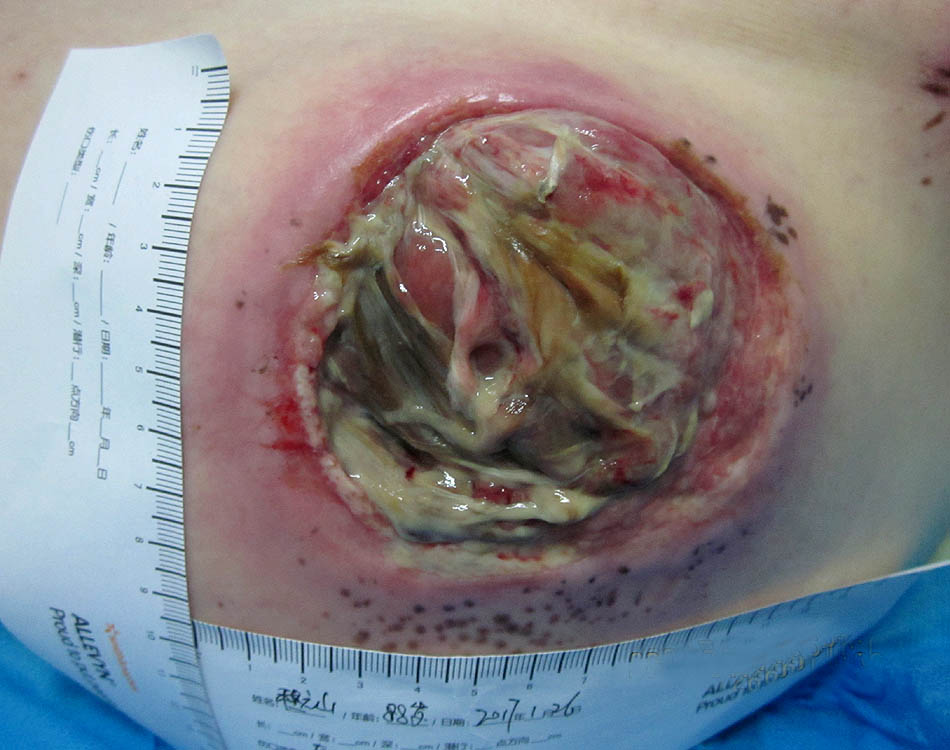
After

Before

After

Before

After

Healed

Before

After

Healed

Before

After
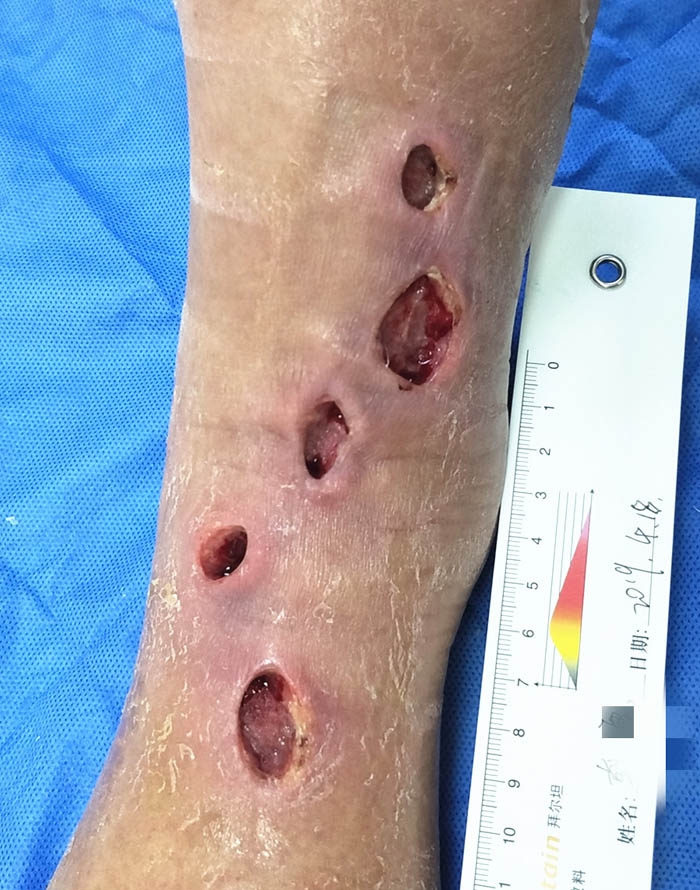
Healed

Before

After

Before

After

Before

After

Before

After

Before

After

Before

After

Before

After

Before

After

Before

After

Before

After


